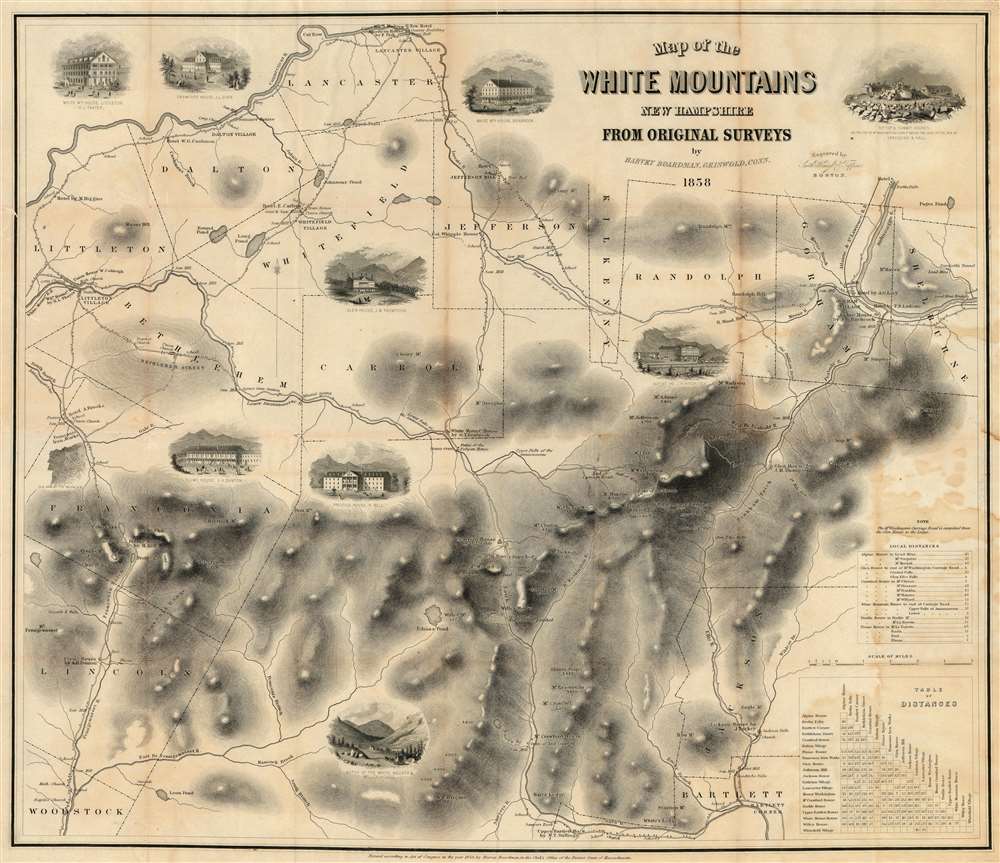
This item below is out of stock, but another example (left) is available. To view the available item, click "Details."
Details
1859 Boardman Map of the White Mountains, New Hampshire
$1,200.00
1859 Boardman Map of the White Mountains in New Hampshire
WhiteMountains-boardman-1859
Title
1859 (dated 1858) 19.5 x 22.5 in (49.53 x 57.15 cm) 1 : 102000
Description
Publication History and Census
This map was first printed in 1858 as a separate, folding map, lithographed by John Henry Bufford. A second state, incorporating several corrections (including the transposition of Mt. Jefferson and Mt Adams) was executed the following year under the imprint of Smith, Knight and Tappan. This second state was sold both as a separate (in boards with the original date, as here) and also was included in Boardman's Complete and Accurate Guide to and Around the White Mountains (Crosby, Nichols and Co., Boston) 1859. A further state, printed by H. S. Fifield in 1861, also exists. Overall the map is well represented in institutional collections, but the separate issue of this second state appears to be scarce, only appearing three times in OCLC. We are aware of twelve examples in auctions and dealers' catalogues going back as far as 1911.CartographerS
Harvey Boardman (October 14, 1833 - September 17, 1863) was an American surveyor and engineer in Griswold, Connecticut. The son of a wealthy farmer, it is likely that he was well educated, but we have no account of his particular training: accounts from 1857 have him surveying the White Mountains personally with an odometer, which suggests some expertise. He was acquainted with various important contemporaries in the surveying field, such as Arnold Guyot and the engraver J. H. Bufford. He was drafted into the Army in 1863 but refused to serve, believing that the Federal government had no constitutional power to prevent secession. He was arrested and imprisoned, first in Fort Trumbull in New London, and then Forrest Hall in Washington. The conditions of these prisons were both primitive and inhumane; Boardman died as a result in September of that year. More by this mapmaker...
John Henry Bufford (July 27, 1810 - October 8, 1870) was a Boston based lithographer and printer. Bufford was born in Portsmouth, New Hampshire. He apprenticed as an artist and lithographer at Pendleton Lithography (1825 - 1836) of Boston. In 1835 he relocated to New York where he took independent commissions from George Endicott and Nathaniel Currier, among others. Returning to his hometown of Boston in 1839, he took a position of chief artist with the firm of Benjamin W. Thayer, heir to Pendleton Lithography. He probably married Thayer's sister, Anna Melora Tufts Thayer (1808-1878). Bufford has been highly criticized as an engraver, with one historian, David Tatham, stating he had 'a mediocre sort of craftsmanship at best' and 'no very special skills as an original artist.' We, however, find no justification for this harsh criticism. Instead Bufford gravitated toward business and management. By 1844 Thayer's shop was renamed J. H. Bufford and Company. The firm specialized in decorative sheet music, panoramic views, illustrations for books, retractions of paintings, and commercial printing. Bufford is credited with being one of the first employers and mentors of the important artist and engraver Winslow Homer. Bufford died in 1870, passing on the business to his sons Frank G. Bufford and John Henry Bufford Jr. These young men, operating under the imprint of 'J.H. Bufford's Sons, Manufacturing Publishers of Novelties in Fine Arts', expanded the firm with offices in New York and Chicago. A possibly related lithographic printing firm named Bufford Chandler was incorporated in Boston in 1893. It later relocated to Concord, New Hampshire but closed in 1925 when its state business charter was repealed. Learn More...
George Girdler Smith (September 8, 1795 – December 18, 1878) was an American map and bank note engraver based in Boston throughout the 19th century. Smith was born in Danvers Massachusetts, the son of George Girdler Smith Sr. of Danvers and Sarah Girder of Marblehead. He was the grandson of Silas Smith, a privateer in the early part of the American Revolutionary War. He studied engraving under Abel Bowen Smith until 1815 and subsequently maintained an engraving studio on Boston’s Washington Street. In 1823 (although some suggest as early as 1818) he partnered with fellow Bowen apprentice, William B. Annin to found ‘Annin and Smith’. They were one of Boston’s earliest lithographic printers. As an engraver he worked with several other engravers and printers. In the 1850s he partnered with Charles A. Knight and George H. Tappan as ‘Smith, Knight, and Tappan’. In addition to his engraving work, he was an active churchman and a high-ranking Freemason Learn More...

